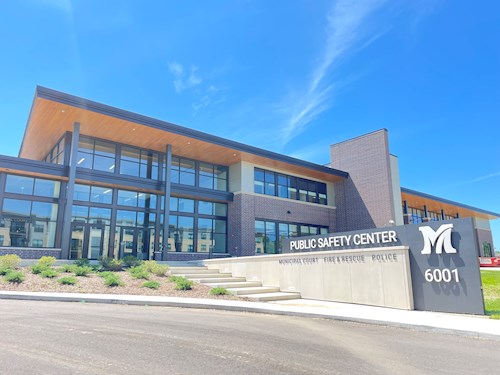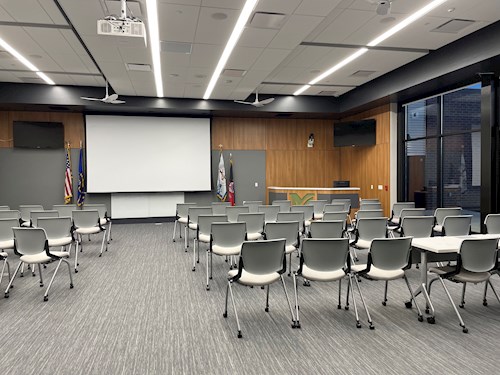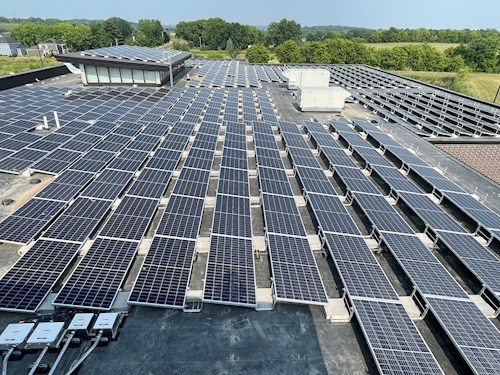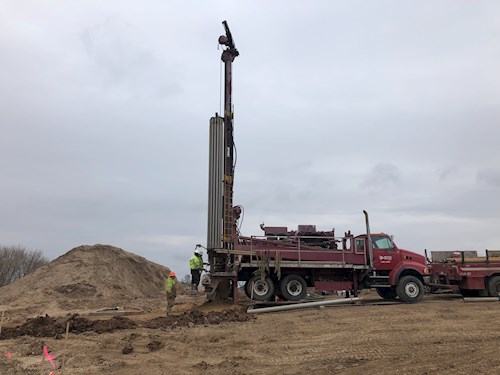
by Kate Duffy
Last week the Village of McFarland celebrated the opening of its new Public Safety Center, likely the first net-zero municipal building in the state of Wisconsin. The building is a shared facility that will house the Fire & Rescue, Municipal Court, and Police Departments, spanning just over 56,000 sq ft. The building includes six apparatus bays and one antique fire truck bay where fire trucks and ambulances are stored. The police wing has office space, a break room, and doubles as an emergency operations center. Three kitchens, a full-service residential kitchen, and living quarters are housed in the facility as well.

All Image Credits: Jordan Schulz
Planning for Net Zero
The concept for the new Public Safety Center as a net zero building emerged in parallel with the Village of McFarland's Sustainability Plan, which helped guide and develop consensus around the inclusion of sustainable choices through design. The Sustainability Plan was the "guiding star" of the project, Village Administrator Matt Schuenke explained. This building is a great opportunity for McFarland to demonstrate their climate action leadership while committing to their new Sustainability Plan.
Partners on this project include Bray Architects, as well as HGA, which completed a Net Zero Energy Study. These Energy Study results help inform the logistics, cost questions, and design implications of how the building can be optimally designed for energy efficiency.
Through this process, the Village of McFarland learned that engaging a sustainable design specialist at the beginning of the planning process to identify energy-efficient choices was a crucial factor in designing a building that has energy efficiency embedded as a priority throughout the life of the project.
Sustainability Features

With 51 geothermal wells for efficient heating and cooling as well as solar panels that can produce up to 470kW of photovoltaic energy, the facility will produce as much energy on-site as it consumes annually, leading to its designation as a net zero facility. Strategic landscaping design utilizing native plantings and bioretention areas will reduce the water and maintenance required to sustain the facility. In addition, EV charging stations are available in the parking lot.


Learning
After completing this building, Village Administrator Matt Schuenke reflected on what they learned during the process. One piece of advice he has is to conduct a feasibility study before starting the design process so that the trade-offs between locations and other decisions are well understood before any design plans are made. The village also faced supply chain and lead time issues that have been quite common since the beginning of COVID-19. For example, the wait time for electrical switchgear was 48 weeks when the construction started whereas the bid submitted assumed 24 weeks.
Problems like these are common and persistence from the whole project team helped push toward the finish line. Matt highlighted the importance of setting specific goals early on that establish where you want to go with the project, and then pushing through cost, impact, and logistical concerns by focusing on that end goal. This focus on impactful results makes it a lot easier to excel through challenges and setbacks.
The Inflation Reduction Act Makes Going Net-Zero Easier
The Inflation Reduction Act (IRA) is making projects like the Public Safety Center even more cost-effective. McFarland decided to move forward with the net-zero design choice because they recognized that in addition to the positive public health and environmental outcomes, the operating expenses of a net-zero building are typically lower, offsetting the upfront costs. During the building's construction, however, the federal government passed the IRA. Under the IRA, renewable energy tax credits are, for the first time, available for this project as well as others looking to integrate geothermal and solar into their buildings. These tax credits make net-zero projects like this one substantially more cost-effective; read more about what the IRA can offer similar buildings on our website.
In addition to demonstrating sustainability leadership and helping similar municipalities envision what is possible, this building is a tangible reminder that the goals in our Climate Action Plan are possible. We hope this project inspires a domino effect of energy-efficient projects around the county. May McFarland's progressive work and dedication inspire you to consider pursuing net zero when designing your next capital project.